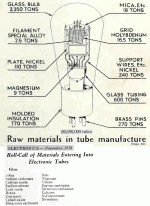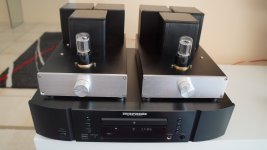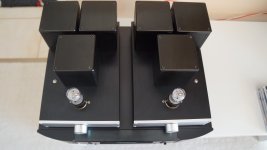...I wonder, then, why certain tubes ...virtually always have the blue glow while others ...virtually never show it ...
I do not know. (Have not noticed.) The 6550 is often run at 600V, the EM7 at 140V; but 6AQ5 is more often 250-300. Maybe plate holiness has a lot to do with it.
But what I really want to show is something I found: how much glass is in a tube (circa 1930!). About 59% of the '27, '24, '45 types in 1930 is glass. So, very important, mainly that it be serviceable and cheap.
The list of ingredients for glass is long; but glass makers had all kinds of (not-so) secret recipes to adjust liquidity, strength, hardness, to cut key contaminants, etc.
ELECTRONICS: Electronics Engineering magazine beginning in 1930
http://www.americanradiohistory.com/Archive-Electronics/30s/Electronics-1930-11.pdf
Attachments
The 6550 is often run at 600V, the EM7 at 140V; but 6AQ5 is more often 250-300. Maybe plate holiness has a lot to do with it.
[/url]
That was one of my thoughts, and from what I've read plate holes ARE involved. Perhaps, too, it's because of higher energy in the electron flow and/or higher current itself allowing more electrons to escape (through plate holes) and making the fluorescence stronger. Hmmmm. Guess I'll do more reading.
my friend Fred was clever an practical guy
that cap was deliberately small
you can even go without it .
In a rush to get one of my mono Minibloks working I completely forgot to remember to include C6, and when I did notice I'd omitted it I figured that there might be some DC blocking on the output of my Marantz CD player. (maybe)
It's good to see some expertise in the mix (Cheers, Zen Mod) recommending that it can be left out. I'd always thought this but wasn't keen on deliberate omission. I'm a believer of "as simple as possible but no simpler" and really what could be simpler than Fred's Miniblok...?
I know just enough to build it, nothing more, and this was the tremendous appeal about Fred's design, and not only that, but his easy-to-follow method of testing. Just the ticket for a wood duck like me...
The one I have running now sounds pretty good, (it's a little over-driven at the moment, according to my tests and feedback from the forum, but seems fine) and I can't wait to finish the other one to check for imaging, depth and soundstage etc...
Unless you know all of your sources have DC blocking at the output, best to keep that cap in place. And as ZM hinted, its size is dependent on the ability of the output transformers to handle low frequencies. If you're using the cheap Hammond OPTs, stick with 0.1uF. If you have larger/more capable OPTs you could increase it.
BTW, seems like it's possible that if you have DC on the input and no C6, that might well drive you into distortion by changing the bias. When you say "overdriven" I assume you mean you are getting distortion early on in the volume pot position?
BTW, seems like it's possible that if you have DC on the input and no C6, that might well drive you into distortion by changing the bias. When you say "overdriven" I assume you mean you are getting distortion early on in the volume pot position?
With regard to 'overdriven', I was referring to the difference between Fred's values and the ones I was measuring, and also to conversations with yourself and Allensoncanon. That was it really. I'm not hearing any distortion at my suitable volume level, but I'm assuming that my tube is being driven at the higher end of its rated value. I've yet to complete the second monoblock.
With regard to C6, I'm using custom wound OPT's, which I hope are better than the generic Hammonds, so probably no need to increase the value of C6...
With regard to C6, I'm using custom wound OPT's, which I hope are better than the generic Hammonds, so probably no need to increase the value of C6...
My bad, I should have written that since I'm using a better OPT than the generic Hammonds, I should consider a higher value for C6 as suggested by Carlp. I've got some PIO Russian caps in my stash, maybe I've got a couple suitable...
My OPT's have a rated value down to 20Hz, although I think that might be optimistic.
For the first round, I'll make the second monoblock the same as the first so I'm on a level playing field, and then I can make changes one by one. I doubt that with my cloth ears and tinnitus I'll hear much difference, but you never know...
My OPT's have a rated value down to 20Hz, although I think that might be optimistic.
For the first round, I'll make the second monoblock the same as the first so I'm on a level playing field, and then I can make changes one by one. I doubt that with my cloth ears and tinnitus I'll hear much difference, but you never know...
Hi Folks,
Finished both Miniblok monoblocks. The first one worked right out of the box as described elsewhere, but I committed the cardinal sin of not testing the second one. The first is fine so I just copied the wiring for the second one, checking and double checking as I went. The second one gets power, the tube lights up but there's nobody home, not a cracker. I removed the cover and replaced the signal wire connections cos I thought the fault might be there. At this stage I still haven't run a meter over it, other household tasks demand my attention, so it sits there all forlorn.
I'll get to it this coming week but I've got no idea where to look if Fred's testing procedure doesn't reveal anything amiss. All the transformers are potted and if it happens that any of them aren't working, especially the OPT then it means a new OPT, cover and potting mix.
A couple of pix.. err, no. I don't know how to add them. Something about adding the URL for the location of the pix. They're on my desktop , that's all I know...
Can anyone advise?
Cheers, Martin
Finished both Miniblok monoblocks. The first one worked right out of the box as described elsewhere, but I committed the cardinal sin of not testing the second one. The first is fine so I just copied the wiring for the second one, checking and double checking as I went. The second one gets power, the tube lights up but there's nobody home, not a cracker. I removed the cover and replaced the signal wire connections cos I thought the fault might be there. At this stage I still haven't run a meter over it, other household tasks demand my attention, so it sits there all forlorn.
I'll get to it this coming week but I've got no idea where to look if Fred's testing procedure doesn't reveal anything amiss. All the transformers are potted and if it happens that any of them aren't working, especially the OPT then it means a new OPT, cover and potting mix.
A couple of pix.. err, no. I don't know how to add them. Something about adding the URL for the location of the pix. They're on my desktop , that's all I know...
Can anyone advise?
Cheers, Martin
Sorry to hear that, Martin.
First thing I'd do is swap tubes to ensure one isn't dead. But see my caveat in the next paragraph before you even do that. If it's still the same, then I'd go through Fred's testing procedure. You are VERY likely to find the problem that way. Likely problem is a bad connection (especially ground). If you don't find it that way, or find the problem but can't figure out how to fix it, post back with the info.
BTW, I'd highly recommend against trying to run a new (or new to you) tube amp without any testing. You could destroy your speakers that way (e.g. if you have DC on an output) or the output transformers, etc. Better to wire an 8+/- ohm power resistor of at least 10watts across the outputs and then run the tests. If it passes all tests and you've checked for DC on the outputs and found no more than tens of mV levels, then I'd wire it up and try again. If there's still a problem, swap input cables and see if the problem switches sides and is therefore BEFORE the amp. No problem? Switch speaker cables and see if there is a speaker problem. BTW, if the dummy load resistors heat up, particularly without a signal, there's probably DC on the output.
Note that just copying wiring is prone to problems, particularly phase related problems, but also potentially serious problems.
Good luck. I look forward to your next post.
First thing I'd do is swap tubes to ensure one isn't dead. But see my caveat in the next paragraph before you even do that. If it's still the same, then I'd go through Fred's testing procedure. You are VERY likely to find the problem that way. Likely problem is a bad connection (especially ground). If you don't find it that way, or find the problem but can't figure out how to fix it, post back with the info.
BTW, I'd highly recommend against trying to run a new (or new to you) tube amp without any testing. You could destroy your speakers that way (e.g. if you have DC on an output) or the output transformers, etc. Better to wire an 8+/- ohm power resistor of at least 10watts across the outputs and then run the tests. If it passes all tests and you've checked for DC on the outputs and found no more than tens of mV levels, then I'd wire it up and try again. If there's still a problem, swap input cables and see if the problem switches sides and is therefore BEFORE the amp. No problem? Switch speaker cables and see if there is a speaker problem. BTW, if the dummy load resistors heat up, particularly without a signal, there's probably DC on the output.
Note that just copying wiring is prone to problems, particularly phase related problems, but also potentially serious problems.
Good luck. I look forward to your next post.
In fact, even if you swap the tubes and that indicates a bad tube, you should still go through Fred's testing. It is important but also will help you understand more about tube amps. It was one of the reasons for trying this amp as a first project. The circuit is quite complex as single-ended tube amps go (he uses a creative but unusual grid bias on the output stage, a voltage doubler PS and an interesting PS transformer setup to mention a few), so I wouldn't normally recommend it as a first project. It is entirely Fred's descriptions that make it worth trying. He was VERY thorough and easy to follow.
Note the OPTs should protect against any DC on the output UNLESS there's a problem with the OPTs...
Note the OPTs should protect against any DC on the output UNLESS there's a problem with the OPTs...
Thanks for those kind words Carlp. The very first thing I did was change the tube. No difference, so I swapped the RCA cables over. No change, in that the other amp kept playing. Then I re-soldered the input leads just in case. I used a watchmakers illuminated eyeglass to check for dodgy connections. Nothing that I could see. Checked the wiring against the other amp. All looks the same. All done before I looked for my meter and couldn't find it. Ah, bugger it, I'll look tomorrow. Tomorrow came and I had other things to do so I'll fish out my meter from its hiding place and get stuck in during the week. I so wanted, and expected, to be listening to Dire Straits as soon as both amps warmed up. But it was not to be...
PS, the one thing I didn't do but should have was swap the speaker wires to the other speaker, to rule in or out a dodgy speaker. I did check the speaker leads to the speaker and everything looked ok...
PS, the one thing I didn't do but should have was swap the speaker wires to the other speaker, to rule in or out a dodgy speaker. I did check the speaker leads to the speaker and everything looked ok...
Last edited:
Panic over boys,
Turned out that the problem with the second Miniblok was a dud joint on one of the speaker jack connections. A quick re-solder and all is well...
Carlp mentioned that he didn't think this amp was suitable as a first project. If it wasn't for Fred's brilliant build-description I would have to agree to a large extent. I'm a complete noob to tubes/valves but I have for many years wanted to build a simple tube amp preferably from a schematic rather than a kit. And preferably to get a taste of SET.
Fred Nachbaur's Miniblok is just the ticket, and I certainly wouldn't dissuade a noob from having a go. If I did it, anyone can even someone with as little experience as I have. Of course, the caveat is that some LETHAL voltage is present and the builder MUST take every precaution and follow Fred's testing instructions to the letter.
All that being said, this build was highly enjoyable and I loved every minute of it. I want to enjoy it, let it get settled in, and then I might fiddle with some alternative ideas as mentioned by some capable contributors who helped me along the way.
I thank you all for your input...
I spent rather more money than Fred intended for this fairly simple design, but I wanted something I could be proud of (not to say I wouldn't have been proud of having built it as originally intended), but I wanted the footprint bigger to give me more room and I was keen on potting the transformers in nice looking covers.
I still haven't sussed how to send pictures, but if anyone is willing to share their knowledge, I'd appreciate it. It can't be too hard surely..
I should mention my thoughts as to how they sound...
Well, it's not easy to say with brand new tubes etc, but I tend to listen to familiar recordings, listening for small details I know are present in other amps. For instance in Dire Straight's Private Investigations, there is a tiny sound of tinkling glass, just after a cat's meow, as though a bottle has been dropped and it smashes on the ground. It's an indistinct sound and you have to really listen for it. It's as clear as day on my other tube amp, so I need to hear it clearly on these new ones. I've got bad tinnitus but I can hear it, not quite as well as on my EL34 amp, but it's there...
So I need to spend a lot more time running in these monoblocks to see if they eventually ooze some chocolaty goodness. I expect they will, not from my build skills necessarily but as much from Fred's remarkable schematic...
Many thanks all...
Turned out that the problem with the second Miniblok was a dud joint on one of the speaker jack connections. A quick re-solder and all is well...
Carlp mentioned that he didn't think this amp was suitable as a first project. If it wasn't for Fred's brilliant build-description I would have to agree to a large extent. I'm a complete noob to tubes/valves but I have for many years wanted to build a simple tube amp preferably from a schematic rather than a kit. And preferably to get a taste of SET.
Fred Nachbaur's Miniblok is just the ticket, and I certainly wouldn't dissuade a noob from having a go. If I did it, anyone can even someone with as little experience as I have. Of course, the caveat is that some LETHAL voltage is present and the builder MUST take every precaution and follow Fred's testing instructions to the letter.
All that being said, this build was highly enjoyable and I loved every minute of it. I want to enjoy it, let it get settled in, and then I might fiddle with some alternative ideas as mentioned by some capable contributors who helped me along the way.
I thank you all for your input...
I spent rather more money than Fred intended for this fairly simple design, but I wanted something I could be proud of (not to say I wouldn't have been proud of having built it as originally intended), but I wanted the footprint bigger to give me more room and I was keen on potting the transformers in nice looking covers.
I still haven't sussed how to send pictures, but if anyone is willing to share their knowledge, I'd appreciate it. It can't be too hard surely..
I should mention my thoughts as to how they sound...
Well, it's not easy to say with brand new tubes etc, but I tend to listen to familiar recordings, listening for small details I know are present in other amps. For instance in Dire Straight's Private Investigations, there is a tiny sound of tinkling glass, just after a cat's meow, as though a bottle has been dropped and it smashes on the ground. It's an indistinct sound and you have to really listen for it. It's as clear as day on my other tube amp, so I need to hear it clearly on these new ones. I've got bad tinnitus but I can hear it, not quite as well as on my EL34 amp, but it's there...
So I need to spend a lot more time running in these monoblocks to see if they eventually ooze some chocolaty goodness. I expect they will, not from my build skills necessarily but as much from Fred's remarkable schematic...
Many thanks all...
Last edited:
Nice builds, logotrikes! Way nicer than mine. BTW, all I was trying to say about the project difficulty is that without Fred's descriptions it would be way beyond a first-timer. It was my first tube project and I succeeded right off the bat largely due to Fred's explanations. Complexity and the high voltage, though, makes me think twice about recommending it to some people.
Going good
Hi Carlp,
Happy to report that the amps are going very well. Heaps of power it seems, far more than I expected from such a measly output. Goes to show what one decent watt can actually do, and that mega watt and mega buck systems aren't the only game in town with regard to audio satisfaction.
I'm not yet convinced that these spuds are any better than my triode-strapped EL34 set, but as a home-build I'm very satisfied, constructor-bias notwithstanding...
Regards,
martin
Hi Carlp,
Happy to report that the amps are going very well. Heaps of power it seems, far more than I expected from such a measly output. Goes to show what one decent watt can actually do, and that mega watt and mega buck systems aren't the only game in town with regard to audio satisfaction.
I'm not yet convinced that these spuds are any better than my triode-strapped EL34 set, but as a home-build I'm very satisfied, constructor-bias notwithstanding...
Regards,
martin
Hi Folks,
My wife and I have been over in the UK, and having been back for a month or so I'm back into listening to Fred's lovely little SET's with all their chocolaty goodness.
I haven't got around to doing any mods yet, and I might not even bother. I've got some ideas about building a pair of flat panel speakers, driven by resonance drivers or whatever they're called, but first I'd like to do a Youtube video about my experience with the Miniblok's, to perhaps help someone on the way. Hopefully not the blind leading the blind because I picked up a few tips as I went. I can't speak with any great authority but a few pictures and an oral description should help folks.
I'm still not convinced that the Miniblok's sound any better than my triode-strapped EL34 amp, but I'm not really concerned. Actually though, the more I play the Miniblok's the more punchier and immediate they seem to be sounding. They seem to be opening up and developing something of a 3D soundstage, with a little more attack, but I can still clearly hear the speakers, ie, they don't disappear completely. That's more to do with the speakers themselves rather than the amps. I've had these speakers since Adam was a lad, and it's time for a change. I've hung on to them because they're quite efficient, and I like 'em.
I could probably convince the boss that I desperately need a pair of the latest greatest purpose-built speakers from the finest purveyors of audio excellence in the land, but of course we don't work that way. It has to be DIY and lashings of constructor-bias. The only way to fly...
Look out on Youtube for something like "Fred Nachbaur's Miniblok SET amplifier build"
Cheers, Martin
My wife and I have been over in the UK, and having been back for a month or so I'm back into listening to Fred's lovely little SET's with all their chocolaty goodness.
I haven't got around to doing any mods yet, and I might not even bother. I've got some ideas about building a pair of flat panel speakers, driven by resonance drivers or whatever they're called, but first I'd like to do a Youtube video about my experience with the Miniblok's, to perhaps help someone on the way. Hopefully not the blind leading the blind because I picked up a few tips as I went. I can't speak with any great authority but a few pictures and an oral description should help folks.
I'm still not convinced that the Miniblok's sound any better than my triode-strapped EL34 amp, but I'm not really concerned. Actually though, the more I play the Miniblok's the more punchier and immediate they seem to be sounding. They seem to be opening up and developing something of a 3D soundstage, with a little more attack, but I can still clearly hear the speakers, ie, they don't disappear completely. That's more to do with the speakers themselves rather than the amps. I've had these speakers since Adam was a lad, and it's time for a change. I've hung on to them because they're quite efficient, and I like 'em.
I could probably convince the boss that I desperately need a pair of the latest greatest purpose-built speakers from the finest purveyors of audio excellence in the land, but of course we don't work that way. It has to be DIY and lashings of constructor-bias. The only way to fly...
Look out on Youtube for something like "Fred Nachbaur's Miniblok SET amplifier build"
Cheers, Martin
Last edited:
- Status
- This old topic is closed. If you want to reopen this topic, contact a moderator using the "Report Post" button.
- Home
- Amplifiers
- Tubes / Valves
- Fred Nachbaur SET amp: input capacitor



